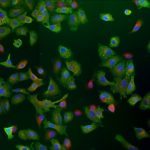Link to Pubmed [PMID] – 19225004
Link to DOI – 10.1128/JVI.01987-08
J Virol 2009 May; 83(9): 4704-8
Following circulation of avian influenza H5 and H7 viruses in poultry, the hemagglutinin (HA) can acquire additional glycosylation sites, and the neuraminidase (NA) stalk becomes shorter. We investigated whether these features play a role in the pathogenesis of infection in mammalian hosts. From 1996 to 2007, H5N1 viruses with a short NA stalk have become widespread in several avian species. Compared to viruses with a long-stalk NA, viruses with a short-stalk NA showed a decreased capacity to elute from red blood cells and an increased virulence in mice, but not in chickens. The presence of additional HA glycosylation sites had less of an effect on virulence than did NA stalk length. The short-stalk NA of H5N1 viruses circulating in Asia may contribute to virulence in humans.


